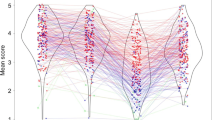Abstract
Six experiments investigated the commonly expressed view that the pronoun he, when used generically, may lead individuals to think more often of male referents. The first experiment validated a semantic differential scale which was constructed to unobtrusively measure subjects' impressions of stimulus persons. In the five subsequent experiments, descriptions of various stimulus persons were presented alternating the use of the pronouns he, they, or he/she. No support was found for a pure pronoun effect. However, some evidence was found for a masculine bias when the word man was combined with he. The results provide little support for the often cited claim that the use of the generic pronoun, per se, leads to increased thoughts of men.
Similar content being viewed by others
References
APA Task Force on Issues of Sexual Bias in Graduate Education. Guidelines for nonsexist use of language. American Psychologist, 1975, 30, 682–684.
Broverman, I. K., Vogel, S. R., Broverman, D. M., Clarkson, F. E., & Rosenkrantz, P. S. Sex-role stereotypes: A current reappraisal. Journal of Social Issues, 1972, 28, 59–77.
Geivitz, J. Another plea for “E.” APA Monitor, August 1978, p. 3.
Harrison, L. Cro-magnon woman — in eclipse. Science Teacher, 1975, 42 (April), 8–11.
Kidd, V. A study of the images produced through the use of male pronouns as the generic. Moments in Contemporary Rhetoric and Communications, 1971, 1, 25–29.
Lakoff, R. Language and women's place. New York: Harper & Row, 1975.
Martyna, W. What does “he” mean? Use of the generic masculine. Communication, 1978, 3, 131–138.
Miller, C., & Swift, K. Words and women. New York: Anchor/Doubleday, 1976.
Moulton, J., Robinson, G. M., & Elias, C. Sex bias in language use. “Neutral” pronouns that aren't. American Psychologist, 1978, 33, 1032–1036.
Osgood, C. E., Suci, G. J., & Tannenbaum, P. H. The measurement of meaning. Urbana: University of Illinois Press, 1957.
Schneider, J. W., & Hacker, S. L. Sex role imagery and use of the generic “man” in introductory texts: A case in the sociology of sociology. American Sociologist, 1973, 8, 12–18.
Spencer, N. J. Can “she” and “he” coexist? American Psychologist, 1978, 33, 782–783.
Worthy, M., & Craddick, R. A. A semantic differential investigation of sexually symbolic concepts. Journal of Projective Techniques and Personality Assessment, 1969, 33, 78–80.
Author information
Authors and Affiliations
Additional information
The authors would like to thank Melodie Smith for serving as an experimenter in Experiment 5 and for assisting with data summary.
Rights and permissions
About this article
Cite this article
Cole, C.M., Hill, F.A. & Dayley, L.J. Do masculine pronouns used generically lead to thoughts of men?. Sex Roles 9, 737–750 (1983). https://doi.org/10.1007/BF00289802
Issue Date:
DOI: https://doi.org/10.1007/BF00289802




